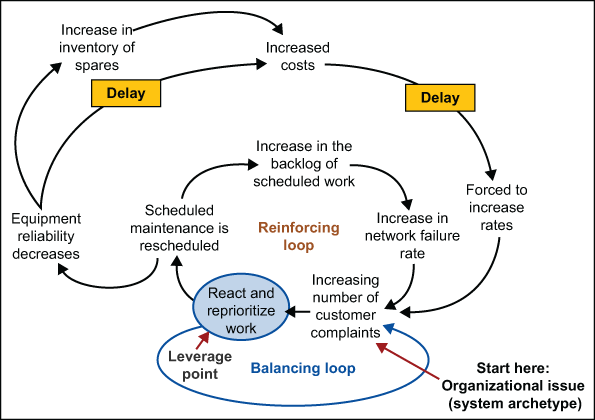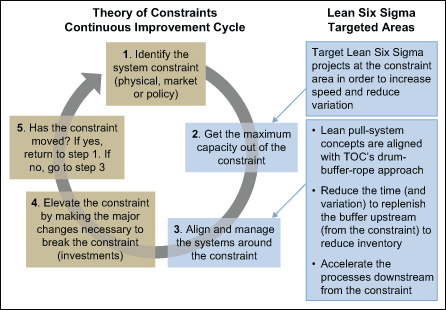
Lean Six Sigma (LSS) has demonstrated the ability to produce outstanding results; over time, however, returns from LSS may begin to slow. One of the more common reasons cited for slowing returns is poorly targeted projects. This occurs because organizations fail to recognize that continuous improvement efforts need to be addressed on a systemic level rather than within a department or function in isolation. Although improvement projects carried out in isolation can yield short-term results, they also can translate into having minimal, or even a negative, impact on overall organizational performance.
In order to achieve maximum and consistent returns with LSS, efforts must be focused on improving overall system performance. Seeing and understanding the whole system can be accomplished by combining Lean Six Sigma with systems thinking and the theory of constraints (TOC). This article demonstrates the necessity and benefits of combining these methodologies into a single continuous improvement approach.
Systems Thinking: The Opposite Approach to Lean Six Sigma
Continuous improvement programs that use LSS generate improvements by disassembling the process into smaller pieces. This is known as an analytical approach. However, often an analytical approach will fail to provide an adequate understanding of the problem due to the dynamic complexity of the situation (see table, “Difference in Approaches to Problem Solving” and sidebar, “The Difference Between LSS and Systems Thinking – An Example”). It is within this realm that the tools of systems thinking become a valuable asset to a continuous improvement program.
| Difference in Approaches to Problem Solving | |
| Systems Thinking | Synthesis: understanding the whole by looking at the relationships among its parts. |
| Lean Six Sigma | Analytical: understanding the whole by taking it apart and looking at the pieces. |
The Difference Between LSS and Systems Thinking – An Example
An aircraft can be viewed as a system that has the purpose to fly. With an analytical approach (Lean Six Sigma) to understanding the system, the aircraft (wings, avionics, etc.) is disassembled with the pieces spread out on the hangar floor. After each individual part is analyzed, the function of each of part is understood. But, still, how does the aircraft fly?
That is unknown, because in isolation the parts do not create a system capable of flight. To understand flight, a synthesis approach (systems thinking) must be used to understand how the parts work together to create the necessary conditions to achieve flight.
In this example, an analytical approach helps gain an understanding of what the parts do and how they work. Systems thinking, on the other hand, explains why flight is possible.
The term system is defined as a whole that consists of parts, each of which can affect the others behaviors or properties.1 In other words, performance of the system is determined by how parts interrelate. In business, the manner in which sales, procurement, manufacturing and distribution relate to each other is what drives business performance, not the isolated performance of each department.
An example of how the approaches differ can be found when an organization attempts to improve the efficiency of distribution and warehousing. In an analytical approach, improvements are made based solely on the processes within that department. In reality, the root causes of inefficiencies within that department can originate from any combination of procurement planning, production scheduling and capabilities, sales forecasting, people, the market conditions, and more. Despite the interrelationship between warehousing and other departments throughout the organization, continuous improvement programs launch projects and Kaizen events aimed at making localized improvements in the warehouse. This is not an uncommon occurrence in LSS deployments and can negatively impact a deployment’s ability to maintain momentum and generate returns.
To see the “whole,” systems thinking creates diagrams using reinforcing or balancing feedback loops, system delays and archetypes. A system archetype is a pattern of behavior within a given system, and in the example represents an organizational problem to be addressed.
The example shown in Figure 1 is based on work at a large public energy company that was deploying LSS as well as applying systems thinking. The company created a systems diagram of the customer service department because of an increasing number of customer complaints. The diagram revealed that the decisions made by the department when customer complaints were received was the leverage point in the system. (In systems thinking, a leverage point is where within the system a solution can be applied.)

The company concluded that over time actions taken by the customer service department in response to customer complaints had led to higher costs and more complaints. That conclusion was surprising to company leaders because the department’s key indicators rated customer service among the best-performing departments in the organization. They had expected the cause of increasing customer complaints to stem from issues related to the administration of energy service. The exercise of creating a systems diagram served as a powerful collaborative learning experience that aligned the organization around the need to deploy LSS resources to examine the policies, metrics and processes within the customer service department. Something was clearly amiss if the metrics used to monitor the customer service department suggested excellent performance, yet customer complaints and company costs were rising.
Although this example does not dismiss the need to address problems with equipment reliability or reducing network failures, it does emphasize the need to address the underlying systemic root causes of higher costs and complaints.
Another example of the benefits of combining systems thinking and continuous improvement comes from Dantar Oosterwal, former head of the new product development department at Harley Davidson Motor Company. Oosterwal and his team leveraged systems thinking and Lean to challenge the traditional phase-gate approach to product development. The result was a knowledge-based product development approach that accelerated the average number of new models released to the market per year from 0.74 in 1996 to 4.6 models in 2007 – a dramatic performance increase.2 At the end of his book, Oosterwal emphasized the necessity of systems thinking in continuous improvement programs by stating that “with a focus on tools and techniques there may be a monetary improvement, but the change they usher in will not become embedded as part of the system; the change will just become another fine program.”3 If LSS becomes just another program, then leadership will quickly find ways to better use the resources and a great program will eventually die.
Theory of Constraints: A Structured Approach
The challenge of combining systems thinking with LSS stems from the perception that systems thinking is often too nebulous or academic to implement. TOC provides a structured approach to identifying leverage points, referred to as constraints in TOC language. The TOC is based on the idea that the overall performance of an organization, or system, can be improved by focusing on the increase in throughput at the constraints of the system. Simply stated, a system constraint inhibits throughput of products or services through the organization, therefore reducing the ability to make money, both now and in the future.
According to TOC, constraints typically take three forms: physical, market or policy. Viewing the public utility example through the lens of TOC, the system constraint is the policies within the customer service department. These policies created the metrics, the processes and the culture. The culture drove behaviors that led to actions, which eventually resulted in increased costs and more complaints. TOC encourages the same principles outlined in systems thinking by considering the whole, as well as cause and effect. The TOC uses an intuitive five-step methodology to provide a continuous improvement program for the organization.

As Figure 2 illustrates, TOC provides an effective, step-by-step continuous improvement approach that 1) gives simple and clear guidance on where to improve, 2) communicates how to manage the organization to achieve maximum throughput, and 3) gives guidance on what to do before making additional investments (such as a new technology). When TOC is combined with LSS, the organization significantly increases the effectiveness of targeting projects because resources will be targeted on the system constraints. One study found that combining TOC, Lean and Six Sigma in a logical sequence yielded up to four times better (financial) results than using Lean or Six Sigma alone.4
An excellent example of combining Lean and TOC comes from the U.S. Marine Corps Logistics Center in Albany, Georgia. The MK-48 maintenance team had challenges with capacity and returning repaired vehicles on time to their customers. The team identified a policy that was constraining the throughput of the maintenance process (TOC), then implemented a pull-system (Lean) to schedule maintenance activities. These activities resulted in on-time performance of 99 percent of the production lines.5
Advantages of Looking at the Whole System
To avoid the loss of momentum or slowing results that can come over time, continuous improvement programs must enable the organization to see the whole system while discouraging efforts that are aimed at localized improvements. The examples cited in this article demonstrate the advantages of combining LSS, systems thinking and TOC into a single continuous improvement program, including:
- Significant improvement in targeting of LSS projects
- Improved alignment with leadership goals because continuous improvement efforts will be focused on system performance rather than local optimization
- Intuitive five-step approach of TOC to helps organizations determine where to focus, what to improve and when to consider future investments
- Compatibility and complementary nature of LSS, systems thinking and TOC
- Potential for up to four times better (financial) results than using Lean or Six Sigma alone6
Although the best way to integrate these approaches is beyond the scope of this article, it is safe to say that any integration should include open-mindedness within the LSS program. True continuous improvements professionals understand that in order to continuously improve one must continuously learn.
References
- Ackoff, Russell, “Enabling a Systems Thinking World,” http://www.systemswiki.org/index.php?title=Systems_Thinking_with_Russell_Ackoff, retrieved May 4, 2011.
- Goldratt, Eliyahu M., The Goal: A Process of Ongoing Improvement, The North River Press, 1984.
- Oosterwal, Dantar P., The Lean Machine: How Harley-Davidson Drove Top-line Growth and Profitability with Revolutionary Lean Product Development, American Management Association, 2010.
- Pirasteh, R. M., & Calia, C. G., “Integration of Lean, Six Sigma & TOC Improves Performance,” http://www.industryweek.com/articles/integration_of_lean_six_sigma__toc_improves_performance_21537.aspx?ShowAll=1, retrieved May 3, 2011.
- Srinivasan, M. M., Jones, D., & Miller, A., “Applying Theory of Constraints Principles and Lean Thinking at the Marine Corps Maintenace Center,” Defense Acquisition Review Journal, 135-145, 2008.